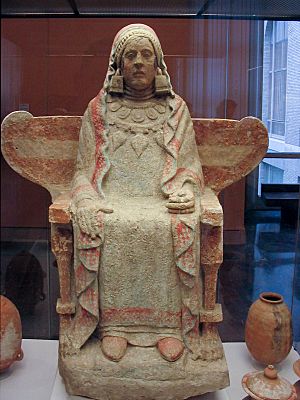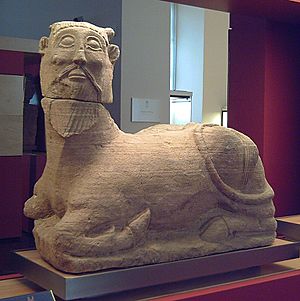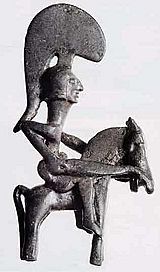Iberian sculpture facts for kids

Iberian sculpture is a type of art made by the Iberians. These ancient people lived in the Iberian Peninsula (modern-day Spain and Portugal). This art style includes many different kinds of sculptures.
Iberian sculpture was created from the Bronze Age until the Romans took over. Because of this, it's sometimes called Pre-Roman Iberian sculpture.
Most Iberian sculptures we still have today show influences from Greek and Phoenician art. You can also see hints of Assyrian, Hittite, and Egyptian styles. Even with these influences, Iberian sculptures have their own special look.
The amount of influence from other cultures often depends on where the sculpture was found. Because of this, experts group Iberian sculptures based on their region.
Contents
Sculptures from the East (Levantine Group)
Most sculptures in the Levantine group were made between the 5th century B.C. and the time the Romans arrived. This group is very well-known in museums.
One of the most famous pieces is a bust called The Lady of Elche. It clearly shows Greek influences. There are over 670 works in this style. They show different looks as new groups of people influenced the region.
Some stone sculptures look like Egyptian sphinxes or Assyrian Lamassu. These are found in areas like Valencia, Alicante, and Albacete. They often look like sphinxes, bulls, or lions.
Famous examples from this group include:
- The Bicha of Balazote, which looks like a man-bull.
- The Lioness of Bocairent (Valencia).
- The Lion of Coy in Murcia.
- The Lions of Baena (Córdoba).
- The Deer of Caudete (Albacete) or the Lady of Caudete.
Many small bronze statues have been found in the Sierra Morena region of Jaén. These are thought to be more local versions of the Levantine style. This style was first influenced by Greek and Eastern art.
From the 5th century BC to the 5th century AD, places like Montealegre used small bronze figures. These were offered as gifts to gods, instead of stone carvings. These sculptures were made by pouring melted bronze into clay molds. Each mold could only be used once, so no two sculptures are exactly alike.
About 4,000 of these bronze sculptures have been found. They show Iberian warriors, riders, people performing religious acts, small horses, and even body parts.
Many Greek and Punic statues and busts made of Terra cotta have been found. These were discovered in burial sites on the islands of Ibiza, La Palma, and Formentera. Also found were small charms made of ivory, metal, or thin stone. The oldest pieces date back to the 8th century B.C. They were likely made until the Romans took control.
These include:
- The Lady of Ibiza.
- Praying Terracotta Figurines (from the 3rd century BC).
Other pieces show Phoenician or Punic origins with Greek influences. These include bronze bull heads found in Majorca, likely used as offerings. A very old Phoenician piece from Galera shows a seated woman, possibly Astarte, with sphinxes on each side.
- The Lady of Galera.
Sculptures from the South (Southern Group)

The southern group of sculptures is mainly found in tombs and other burial monuments. These are located in the Andalusian region. Most of them show strong Phoenician influences.
Key pieces from this group are:
- The sculptures from Cerrillo Blanco.
- The sculptures from The Pajarillo.
- The Punic stone slab from Villaricos (Almeria). It is cone-shaped and has Phoenician writing.
- The Lady of Baza.
- Ivory plates and combs with carvings from Carmona's burial ground.
- A marble coffin shaped like a human, in the Greek style, found in Cadiz.
- Charms with Egyptian-style figures found in tombs in Cadiz and Málaga.
- Other carvings from the Phoenician or Iberian style, but with Roman influences. These were found in Osuna, like the Bull of Osuna.
Sculptures from the West (Western Group)
The western group includes granite funeral stones from Portugal and Galicia. These stones show foot soldiers wearing tunics and carrying round shields. These sculptures are not very detailed. Some have Roman writing added to them, probably much later than when they were first carved.
Sculptures from the Center (Central Group)
In the middle of the Iberian Peninsula, between the Douro and Tagus rivers, there are many granite sculptures. They are roughly carved into the shape of bulls or other animals. Some of these also have Roman writing, which was likely added later.
The most famous of these are the four known as the Bulls of Guisando. Experts believe these were made by the same culture that carved the sphinxes in the Levantine region.
See also
 In Spanish: Escultura ibérica para niños
In Spanish: Escultura ibérica para niños
- South-Western Iberian Bronze
- Iberian schematic art
- Sphinx of Haches
- Torito of Porcuna




